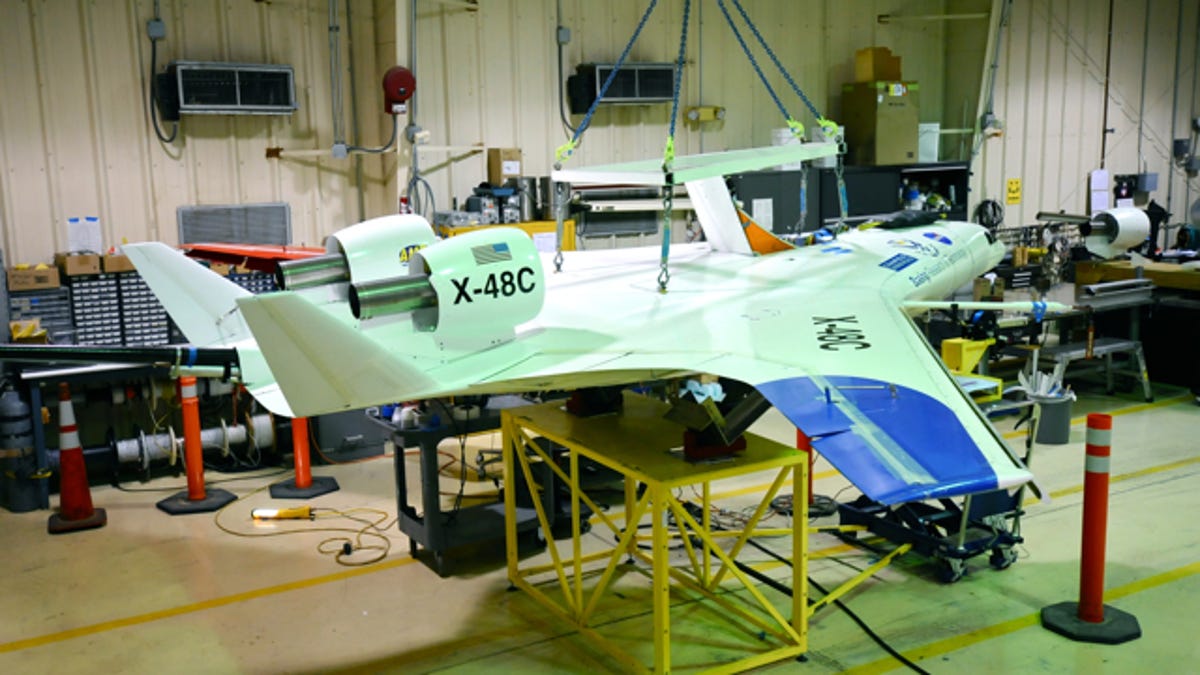At NASA Dryden, the futuristic X-48C gets ready to fly
Could this be the next great aircraft design? Within 10 years, a full-sized version of the hybrid wing body may offer big boosts in range, fuel efficiency, and quiet flight.

EDWARDS AIR FORCE BASE, Calif.--If you want to know what the future of airplane design looks like, you might have to make your way out to the middle of the Mojave Desert.
Tucked away inside a nondescript warehouse building at NASA's Dryden Flight Research Center here, NASA, the U.S. Air Force, Boeing, and Cranfield Aerospace are working on an entirely new kind of plane, one which they hope could someday revolutionize aviation.
Known as a hybrid wing body, the plane design, which NASA describes as a cross between a conventional plane and a flying wing design, is thought to offer long-term benefits in fuel efficiency, fuel capacity, and noise reduction.
Since 2007, the team behind the X-48 project has been working on getting its prototype in the air. Over 92 flights, the X-48B -- an 8.5 percent scale model of an eventual full-size plane -- demonstrated many of the desired features of the design, explained Norm Princen, Boeing's chief engineer on the project.
But now, the team has retired the X-48B and is getting ready to start flying a new version of the design, the X-48C. And with this plane, they've implemented some fairly significant changes. The B version of the plane was a blended-wing design featuring three engines and winglet vertical tails. The C version, which has yet to take flight, has evolved to be even more efficient, Princen said, and because its engines are moved forward in such a way that shields them, it's even quieter than its predecessor. "The engines are above aft center," he explained, "to make sound bounce up or to the side."
Though it looks radically different from today's aircraft, Princen said the idea is that to a pilot, the X-48 would seem very much like a standard transport plane, though it would probably offer a fuel efficiency improvement of between 20 percent and 30 percent. Although it's not yet known exactly what its purpose would be, the thought is that the X-48 would be useful as a tanker, as a command-and-control or transport plane, as a bomber, or as a commercial jetliner. However, because it has no windows outside the cockpit, there's some concern that passengers would be uncomfortable flying in it. To that end, there's some thought that a full-size version could include "virtual" windows, Princen explained. Still, the U.S. Air Force is likely to be the initial customer of the plane.
I've stopped by to see the X-48C as part of Road Trip 2012. The plane, given its small size, is a bit of a surprise. But Princen explained that a full-size version of the X-48 -- which may be about 10 years away -- is likely to have a wingspan of at least 240 feet and be able to fly up to 11,000 nautical miles. Today, however, the X-48C, which should be getting airborne soon, has a top altitude of about 10,000 feet and can stay aloft for just 35 minutes.
Princen and his team expect to fly the X-48C about 20 times, gathering data, and trying to figure out what size the next prototype should be. But rather than being remotely controlled as the B and C versions have been, the next iteration will be human-piloted and will have full capabilities in terms of altitude and range, he said. It is likely to be at least four years before that next version is ready, Princen added.
To be sure, the X-48 project is not the only one competing for the lead in this next generation of planes. Princen said that Lockheed, Northrop Grumman, and Boeing archrival Airbus are all working on some sort of hybrid- or blended-wing design. "The question is not if, but when," he said, "and who will build it."
The main theory behind the new plane is that there is a great deal of internal volume for fuel and cargo inside the main, "welded" area of the hybrid wing design. And because it has a low profile, air "scrubs" over the body more efficiently than today's planes. Princen said that Boeing estimates that fuel efficiency has increased by as much as 50 percent since its 707 jet first took to the skies in the late 1950s, but that the standard engine and wing design may have reached its peak efficiency. "At some point," he said, "you have to make a radical shift in the shape of a plane."



